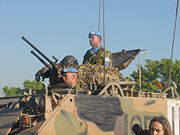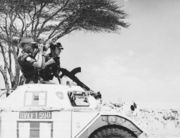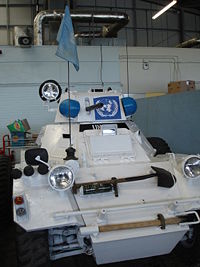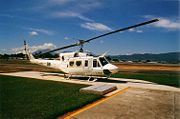Peacekeeping
2008/9 Schools Wikipedia Selection. Related subjects: Conflict and Peace
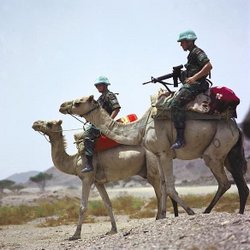
Peacekeeping, as defined by the United Nations, is "a way to help countries torn by conflict create conditions for sustainable peace.". Peacekeepers monitor and observe peace processes in post-conflict areas and assist ex-combatants in implementing the peace agreements they may have signed. Such assistance comes in many forms, including confidence-building measures, power-sharing arrangements, electoral support, strengthening the rule of law, and economic and social development. Accordingly UN peacekeepers (often referred to as Blue Beret because of their light blue helmets) can include soldiers, civilian police officers, and other civilian personnel.
The Charter of the United Nations gives the UN Security Council the power and responsibility to take collective action to maintain international peace and security. For this reason, the international community usually looks to the Security Council to authorize peacekeeping operations, as all UN Peacekeeping missions must be authorized by the Security Council.
Most of these operations are established and implemented by the United Nations itself with troops serving under UN operational command. In these cases, peacekeepers remain members of their respective armed forces, and do not constitute an independent "UN army," as the UN does not have such a force. In cases where direct UN involvement is not considered appropriate or feasible, the Council authorizes regional organizations such as the North Atlantic Treaty Organization (NATO), the Economic Community of West African States, or coalitions of willing countries to undertake peacekeeping or peace-enforcement tasks.
The United Nations is not the only organization to have authorized peacekeeping missions, although some would argue it is the only group legally allowed to do so. Non-UN peacekeeping forces include the NATO mission in Kosovo and the Multinational Force and Observers on the Sinai Peninsula.
Jean-Marie Guéhenno currently serves as the head of the Department of Peacekeeping Operations (DPKO).
Nature of peacekeeping
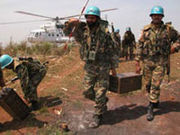
Peacekeeping is anything that contributes to the furthering of a peace process, once established. This includes, but is not limited to, the monitoring of withdrawal by combatants from a former conflict area, the supervision of elections, and the provision of reconstruction aid. Peacekeepers are often soldiers, but they do not have to be. Similarly, while soldier-peacekeepers are sometimes armed, they do not have to engage in combat.
Peacekeepers were not at first expected to ever fight. As a general rule, they were deployed when the ceasefire was in place and the parties to the conflict had given their consent. They were deployed to observe from the ground and reported impartially on adherence to the ceasefire, troop withdrawal or other elements of the peace agreement. This gave time and breathing space for diplomatic efforts to address the underlying causes of conflict.
Thus, a distinction must be drawn between peacekeeping and other operations aimed at peace. A common misconception is that activities such as NATO's intervention in the Kosovo War are peacekeeping operations, when they were, in reality, peace enforcement. That is, since NATO was seeking to impose peace, rather than maintain peace, they were not peacekeepers, rather peacemakers.
Process and structure
Formation
Once a peace treaty has been negotiated, the parties involved might ask the United Nations for a peacekeeping force to oversee various elements of the agreed upon plan. This is often done because a group controlled by the United Nations is less likely to follow the interests of any one party, since it itself is controlled by many groups, namely the fifteen-member Security Council and the intentionally-diverse Secretariat.
If the Security Council approves the creation of a mission, then the Department of Peacekeeping Operations begins planning for the necessary elements. At this point, the senior leadership team is selected (see below). The department will then seek contributions from member nations. Since the UN has no standing force or supplies, it must form ad hoc coalitions for every task undertaken. Doing so results in both the possibility of failure to form a suitable force, and a general slowdown in procurement once the operation is in the field. Romeo Dallaire, force commander in Rwanda during the genocide there, described the problems this poses by comparison to more traditional military deployments:
"He told me the UN was a 'pull' system, not a 'push' system like I had been used to with NATO, because the UN had absolutely no pool of resources to draw on. You had to make a request for everything you needed, and then you had to wait while that request was analyzed...For instance, soldiers everywhere have to eat and drink. In a push system, food and water for the number of soldiers deployed is automatically supplied. In a pull system, you have to ask for those rations, and no common sense seems to ever apply." ( Shake Hands With the Devil, Dallaire, pp. 99-100)
While the peacekeeping force is being assembled, a variety of diplomatic activities are being undertaken by UN staff. The exact size and strength of the force must be agreed to by the government of the nation whose territory the conflict is on. The Rules of Engagement must be developed and approved by both the parties involved and the Security Council. These give the specific mandate and scope of the mission (e.g. when may the peacekeepers, if armed, use force, and where may they go within the host nation). Often, it will be mandated that peacekeepers have host government minders with them whenever they leave their base. This complexity has caused problems in the field.
When all agreements are in place, the required personnel are assembled, and final approval has been given by the Security Council, the peacekeepers are deployed to the region in question.
Cost
Peacekeeping costs, especially since the end of the Cold War, have risen dramatically. In 1993, annual UN peacekeeping costs had peaked at some $3.6 billion, reflecting the expense of operations in the former Yugoslavia and Somalia. By 1998, costs had dropped to just under $1 billion. With the resurgence of larger-scale operations, costs for UN peacekeeping rose to $3 billion in 2001. In 2004, the approved budget was $2.8 billion, although the total amount was higher than that. For the last fiscal year, which ended on June 30, 2006, UN peacekeeping costs were about US$5.03 billion.
All member states are legally obliged to pay their share of peacekeeping costs under a complex formula that they themselves have established. Despite this legal obligation, member states owed approximately $1.20 billion in current and back peacekeeping dues as of June 2004.
Structure
A United Nations peacekeeping mission has three power centers. The first is the Special Representative of the Secretary-General, the official leader of the mission. This person is responsible for all political and diplomatic activity, overseeing relations with both the parties to the peace treaty and the UN member-states in general. They are often a senior member of the Secretariat. The second is the Force Commander, who is responsible for the military forces deployed. They are a senior officer of their nation's armed services, and are often from the nation committing the highest number of troops to the project. Finally, the Chief Administrative Officer oversees supplies and logistics, and coordinates the procurement of any supplies needed.
History
Cold War Peacekeeping
United Nations peacekeeping was initially developed during the Cold War as a means of resolving conflicts between states by deploying unarmed or lightly armed military personnel from a number of countries, under UN command, to areas where warring parties were in need of a neutral party to observe the peace process. Peacekeepers could be called in when the major international powers (the five permanent members of the Security Council) tasked the UN with bringing closure to conflicts threatening regional stability and international peace and security. These included a number of so-called “proxy wars” waged by client states of the superpowers. As of October 2004, there have been 59 UN peacekeeping operations since 1948, with sixteen operations ongoing. Suggestions for new missions arise every year.
The first peacekeeping mission was launched in 1948. This mission, the United Nations Truce Supervision Organization (UNTSO), was sent to the newly created State of Israel, where a conflict between the Israelis and the Arab states over the creation of Israel had just reached a ceasefire. The UNTSO remains in operation to this day, although the Israeli-Palestinian Conflict has certainly not abated. Almost a year later, the United Nations Military Observer Group in India and Pakistan (UNMOGIP) was authorized to monitor relations between the two nations, which were split off from each other following the United Kingdom's decolonization of the Indian subcontinent.
When North Korea invaded South Korea in 1950, the United States responded by leading a United Nations force aimed at retaking all of the Korean Peninsula. The United Nations forces pushed the North Koreans out of the South, and made it to the Chinese border before the People's Liberation Army intervened and pushed the UN back to the 38th parallel. This conflict is today known as the Korean War, and although that war had a cease-fire in 1953, UN forces remained along the demilitarized zone until 1967, when American and South Korean forces took over.
Returning its attention to the conflict between Israel and its Arab neighbors, the United Nations responded to Suez Crisis of 1956, a war between the alliance of the United Kingdom, France, and Israel, and Egypt, which was supported by other Arab nations. When a ceasefire was declared in 1957, Canadian diplomat (and future Prime Minister) Lester Bowles Pearson suggested that the United Nations station a peacekeeping force in the Suez in order to ensure that the ceasefire was honored by both sides. Pearson had initially suggested that the force consist of mainly Canadian soldiers, but the Egyptians were suspicious of having a Commonwealth nation defend them against the United Kingdom and her allies. In the end, a wide variety of national forces were drawn upon to ensure national diversity. Pearson would win the Nobel Peace Prize for this work, and he is today considered a father of modern peacekeeping.
In 1988 the Nobel Peace Prize was awarded to the United Nations peacekeeping forces. The press release stated that the forces "represent the manifest will of the community of nations" and have "made a decisive contribution" to the resolution of conflict around the world.
Since 1991
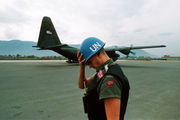
The end of the Cold War precipitated a dramatic shift in UN and multilateral peacekeeping. In a new spirit of cooperation, the Security Council established larger and more complex UN peacekeeping missions, often to help implement comprehensive peace agreements between protagonists in intra-State conflicts and civil wars. Furthermore, peacekeeping came to involve more and more non-military elements that ensured the proper functioning of civic functions, such as elections. The UN Department of Peacekeeping Operations was created in 1992 to support this increased demand for such missions.
By and large, the new operations were successful. In El Salvador and Mozambique, for example, peacekeeping provided ways to achieve self-sustaining peace. Some efforts failed, perhaps as the result of an overly optimistic assessment of what UN peacekeeping could accomplish. While complex missions in Cambodia and Mozambique were ongoing, the Security Council dispatched peacekeepers to conflict zones like Somalia, where neither ceasefires nor the consent of all the parties in conflict had been secured. These operations did not have the manpower, nor were they supported by the required political will, to implement their mandates. The failures—most notably the 1995 massacre in Srebrenica, Bosnia and Herzegovina, and the 1994 Rwandan genocide—led to a period of retrenchment and self-examination in UN peacekeeping.
Non-United Nations Peacekeeping
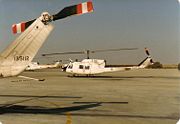
Not all peacekeeping forces have been directly controlled by the United Nations. In 1981, an agreement between Israel and Egypt formed the Multinational Force and Observers which continues to monitor the Sinai Peninsula.
Six years later, an Indian peacekeeping force, IPKF, entered Sri Lanka to help maintain peace. The situation became a quagmire, and India was asked to withdraw in 1990 by the Sri Lankan Prime Minister having formed a pact with the Tamil Tiger rebels.
On 20 December 1995, under a UN mandate, a NATO-led force ( IFOR) entered Bosnia in order to implement The General Framework Agreement for Peace in Bosnia and Herzegovina. In a similar manner, a NATO operation ( KFOR) continues in the Serbian province of Kosovo.
The NATO-led mission in Bosnia and Herzegovina has since been replaced by a European Union peacekeeping mission, EUFOR.
The African Union has also had some limited involvement in peacekeeping within Africa since 2003.
Participation
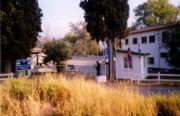
The UN Charter stipulates that to assist in maintaining peace and security around the world, all member states of the UN should make available to the Security Council necessary armed forces and facilities. Since 1948, close to 130 nations have contributed military and civilian police personnel to peace operations. While detailed records of all personnel who have served in peacekeeping missions since 1948 are not available, it is estimated that up to one million soldiers, police officers and civilians have served under the UN flag in the last 56 years. As of November 2005, 107 countries were contributing a total of more than 70,000 uniformed personnel—the highest number since 1995.
Despite the large number of contributors, the greatest burden continues to be borne by a core group of developing countries. The 10 main troop-contributing countries to UN peacekeeping operations as of March 2007 were Pakistan (10,173), Bangladesh (9,675), India (9,471), Nepal (3,626), Jordan (3,564), Uruguay (2,583), Italy (2,539), Ghana, Nigeria and France.
Not all peacekeeping forces have been directly controlled by the United Nations. In 1981, an agreement between Israel and Egypt formed the Multinational Force and Observers which continues to monitor the Sinai Peninsula.
The head of the Department of Peacekeeping Operations, Under-Secretary-General Jean-Marie Guéhenno, has reminded Member States that “the provision of well-equipped, well-trained and disciplined military and police personnel to UN peacekeeping operations is a collective responsibility of Member States. Countries from the South should not and must not be expected to shoulder this burden alone”.
As of May 2004, in addition to military and police personnel, more than 3,400 international civilian personnel, 1,500 UN Volunteers and nearly 6,500 local civilian personnel worked in UN peacekeeping missions.
Until the end of 2005, 2,226 people from over 100 countries have been killed while serving on peacekeeping missions, 1,789 of them being soldiers. Many of those came from India (115), Canada (113) and Ghana (108). Thirty percent of the fatalities in the first 55 years of UN peacekeeping occurred in the years 1993-1995.
Developing nations tend to participate in peacekeeping more than developed countries. This may be due in part because forces from smaller countries avoid evoking thoughts of imperialism. For example, in December of 2005, Eritrea expelled all American, Russian, European, and Canadian personnel from the peacekeeping mission on their border with Ethopia. Additionally, an economic motive appeals to the developing countries. The UN offers contributing nations $1000 per soldier per month, plus equipment. This can be a significant source of revenue for a developing country. By providing important training and equipment for the soldiers as well as salaries, UN peacekeeping missions allow them to maintain larger armies than they otherwise could. About 4.5% of the troops and civilian police deployed in UN peacekeeping missions come from the European Union and less than one percent from the United States (USA).
Criticism
Hypocrisy
Some peacekeeping powers have been accused of being hypocritical and pursuing peacekeeping in order to increase their own international power and prestige. Countries such as Sweden, Italy, United States, Belgium, and the Netherlands have especially been criticized for being major arms suppliers while at the same time pursuing peacekeeping, often in the same areas as they are selling weapons.
Neo-colonialism
Some critics have argued that peacekeeping is a return to the paternalistic ideals of colonialism's " white man's burden." They criticize the UN Charter's call for a global village and the adoption of Western ideals as tactics to justify intervention throughout the globe for the purpose of "keeping the peace". Authors such as Jayan Nayar argue that the UN's global vision is primarily responsible for colonial violence throughout the globe.
Potential for harm to troops
The concern about the harm caused to the troops is twofold. On the other hand, peacekeeping can be extremely stressful. The peacekeepers are exposed to danger caused by the warring parties and often unfamiliar climate. This gives rise to different mental health problems, suicide, and substance abuse. Among former peacekeepers, the frequency of such problems is higher than among the general population. The peacekeepers' families are also in danger, as having one of the parents in a mission abroad is stressful. In addition, peacekeepers, even when acting on UN mandate, may become a target for attacks by some of the parties in a conflict.
Another viewpoint rises the problem that the peacekeeping may soften the troops and erode their combat ability, as the mission profile of a peacekeeping contingent is totally different from the profile of a unit fighting an all-out war.
Long-term problems
Some have criticized peacekeeping for leaving conflicts unresolved. Peacekeeping can have the effect of maintaining an unstable status quo that will inevitably collapse in the long run. However, it is not the job of peacekeepers as presently defined to create a permanent solution. The goal is to stabilize a situation so as to give the politicians and diplomats the opportunity to establish a permanent peace. Relatively new to the UN's peace department are the Peace-building and Peacemaking factions. These have been developed to work in co-ordination with peacekeeping operations; while peacekeepers create a stable environment the peace-builders and peacemakers focus on longer-term, diplomatic aspects, helping to create the conditions for sustainable peace.
Cultural barriers
Because UN Peacekeeping troops are contributed by many nations, some have argued that there are cultural incompatibilities amongst peacekeeping troops, which must be overcome in order to effectively complete their assigned task.
Peacekeeping, human trafficking, and forced prostitution
Reporters witnessed a rapid increase in prostitution in Cambodia, Mozambique, Bosnia, and Kosovo after UN and, in the case of the latter two, NATO peacekeeping forces moved in. In the 1996 U.N. study The Impact of Armed Conflict on Children, former first lady of Mozambique Graça Machel documented: "In 6 out of 12 country studies on sexual exploitation of children in situations of armed conflict prepared for the present report, the arrival of peacekeeping troops has been associated with a rapid rise in child prostitution." There was one highly publicised case where members of the UN peacekeeping force were accused of direct involvement in the procurement of sex slaves for a local brothel in Bosnia. The use of agents for procurement and management of brothels has allowed the military to believe itself shielded from the issue of sexual slavery and human trafficking. Some NATO troops have been linked to prostitution and forced prostitution in Bosnia and Kosovo, as have some UN employees in the Democratic Republic of the Congo, where they were accused of the sexual abuse of underage girls. Proponents of peacekeeping argue that the actions of a few should not incriminate the many participants in the mission, yet NATO and the UN have come under criticism for not taking the issue of forced prostitution linked to peacekeeping missions seriously enough. Most recently, UN troops in Haiti and Sudan have been accused of sexual abuse of children
Proposed reform
Brahimi analysis
In response to criticism, particularly of the cases of sexual abuse by peacekeepers, the UN has taken steps toward reforming its operations. The Brahimi Report was the first of many steps to recap former peacekeeping missions, isolate flaws, and take steps to patch these mistakes to ensure the efficiency of futures peacekeeping missions. The UN has vowed to continue to put these practices into effect when performing peacekeeping operations in the futures.
Rapid reaction force
Many United Nations administrators believe that the ad-hoc style of peacekeeping operations inevitably fails because of deployment and mandate delay when global crises occur. For example, during the Rwandan genocide, the United Nations was unable to garner international support for aid to the country, and 800,000 people were slaughtered. One suggestion to account for these delays is a rapid reaction force: a standing group, administered by the UN and deployed by the UN Security Council, that receives its troops and support from current Security Council members and is ready for quick deployment in the event of future genocides.
